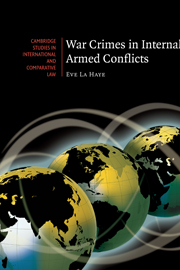Book contents
- Frontmatter
- Contents
- Acknowledgements
- List of abbreviations and acronyms
- Introduction
- 1 Towards a workable definition of internal armed conflicts
- 2 The laws of war applicable in internal armed conflicts
- 3 The regime of war crimes
- 4 Individual criminal responsibility for war crimes committed in internal armed conflicts
- 5 National prosecutions of war criminals and internal armed conflicts
- 6 International prosecutions of war criminals and internal armed conflicts
- Concluding remarks
- Select bibliography
- Index
Introduction
Published online by Cambridge University Press: 27 July 2009
- Frontmatter
- Contents
- Acknowledgements
- List of abbreviations and acronyms
- Introduction
- 1 Towards a workable definition of internal armed conflicts
- 2 The laws of war applicable in internal armed conflicts
- 3 The regime of war crimes
- 4 Individual criminal responsibility for war crimes committed in internal armed conflicts
- 5 National prosecutions of war criminals and internal armed conflicts
- 6 International prosecutions of war criminals and internal armed conflicts
- Concluding remarks
- Select bibliography
- Index
Summary
For the second year running, all the major armed conflicts in the world in 2004 and 2005 fell within the category of internal armed conflicts. The UN Secretary-General remarked that ‘as internal armed conflicts proliferate, civilians have become the principal victims. It is now conventional to say that, in recent decades, the proportion of war victims who are civilians has leaped dramatically to an estimated 75 per cent and in some cases even more … Furthermore, and particularly in conflicts with an element of ethnic or religious hatred, the affected civilians tend not to be the incidental victims of these new irregular forces: they are their principal object.’ Since 1949, a growing body of international norms has become applicable in internal armed conflicts, but at the same time actual observance of these rules by belligerents has been limited. An example of this phenomenon is the agreement reached between the parties to the conflict in Bosnia-Herzegovina on 22 May 1992 whereby all belligerents recognised the applicability of substantive principles of the laws and customs of war to the conflicts in Bosnia. The four following years of conflicts and the fall of Srbrenica are tragic evidence of the extent to which this agreement was disregarded in practice.
Bert Röling noted that ‘the laws of war derive their authority, during a war, from the threat of reprisals, prosecution and punishment after the war’.
- Type
- Chapter
- Information
- War Crimes in Internal Armed Conflicts , pp. 1 - 4Publisher: Cambridge University PressPrint publication year: 2008

